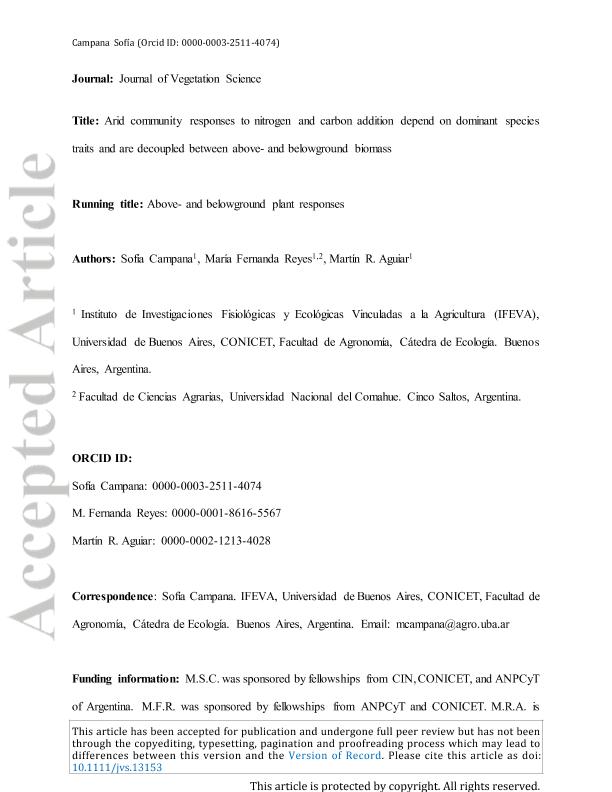Artículo
Arid community responses to nitrogen and carbon addition depend on dominant species traits and are decoupled between above- and below-ground biomass
Fecha de publicación:
09/2022
Editorial:
Wiley Blackwell Publishing, Inc
Revista:
Journal of Vegetation Science
ISSN:
1100-9233
Idioma:
Inglés
Tipo de recurso:
Artículo publicado
Clasificación temática:
Resumen
Questions: Arid communities are strongly limited by soil resources including water and nitrogen (N). Plants compete for N with other plants and microorganisms, which are also limited by carbon (C). We propose that above- and below-ground plant responses to soil resources are modulated by community structure (species relative abundances, “mass ratio hypothesis”) and species traits (relative growth rates — RGRs). We evaluated the single and combined effects of soil N and C addition on the above- and below-ground biomass accumulation of perennial grass patches in an arid community, and the mechanisms involved in their responses. Location: Patagonian steppe, Argentina. Methods: We added N (2 g N m−2; NH4NO3) and C (330 g C m−2; sucrose) to 1-m2 field plots in a factorial design. After two years, we harvested above-ground (n = 5 plots) and below-ground biomass (n = 10 soil cores) and sorted it by species. We measured potential soil respiration as a proxy of microbial activity. Results: Total above-ground biomass increased by 55% as a result of N and decreased by 45% as a result of C addition, in relation to controls. C addition reduced total below-ground biomass by 42%. The above-ground differences were associated with changes in the biomass of dominant species according to their RGRs. Poa ligularis (dominant, high RGR) increased by 92% as a result of N addition while Pappostipa speciosa (dominant, low RGR) decreased by 55% as a result of C addition. Intermediate and subordinate grasses did not modify their biomass, independently of their RGR. Potential soil respiration was three times higher in plots with C addition than in control plots. Conclusions: Community biomass was explained by a combination of mass ratio hypothesis and specific RGR, as dominant grasses controlled above-ground community responses to N (high-RGR species) and C addition (low-RGR species). Our findings highlight the independence between the above- and below-ground processes and the importance of considering community equitability and species characteristics to predict plant community responses to changes in soil resources.
Archivos asociados
Licencia
Identificadores
Colecciones
Articulos(IFEVA)
Articulos de INST.D/INV.FISIOLOGICAS Y ECO.VINCULADAS A L/AGRIC
Articulos de INST.D/INV.FISIOLOGICAS Y ECO.VINCULADAS A L/AGRIC
Citación
Campana, María Sofía; Reyes, María Fernanda; Aguiar, Martin Roberto; Arid community responses to nitrogen and carbon addition depend on dominant species traits and are decoupled between above- and below-ground biomass; Wiley Blackwell Publishing, Inc; Journal of Vegetation Science; 33; 5; 9-2022; 1-8
Compartir
Altmétricas




